by Winding Pathways | Apr 30, 2020 | Uncategorized
With Kathleen Horan,
president and CEO of AbbeHealth
We are all now several months into coping with the novel coronavirus pandemic and subsequent COVID-19 disease.
It’s felt like having to walk across a high wire above Niagara Falls with no safety equipment. That stunt was done in 1859 by Jean-Francois Gravelet, also known as Charles Blondin. Totally dangerous. Crazy. Yet, Blondin understood the dangers and had prepared for many years ahead of time.
A salient lesson for today.
While initially, everything seemed topsy turvy in our world, many have found a semblance of a routine that has helped keep insanity at bay. Yet, as this wears on, we find we are wearing out.
Now is exactly the time to remain mindful. And, remember we do have individual and communal safety nets. So, let’s take a look at these.
The Importance of Routine
Kathleen Horan, director of AbbeHealth, points out that “Most people find comfort in routine and predictability. These fundamental comforts have been disrupted leading to anxiety and stress and sometimes a sense of helplessness because it feels like everything is out of control.”
While some compare the coronavirus pandemic with stressful and location-specific disasters such as floods, wildfires, hurricanes, or plane crashes, these disasters are different and require different responses.
“With the 2008 Epic Surge of floodwaters in Eastern Iowa, the lead up was relatively short-lived, the surge came and was devasting, and then we quickly moved in to clean up and recovery stage. We had things to do to start moving back to what we considered ‘normal’.
“With the novel coronavirus and the COVID-19 disease, the anticipation of what might be coming and the unknowns about what lies ahead are very difficult because it feels so out of our control.”
A joke going around is that while the Greatest Generation was called to go to war (WWII). We are called to the couch. We have developed “new” routines and habits. Let’s continue the positive ones after the pandemic has passed.
Revisiting the Grief Cycle and Spiral
With no obvious end in sight, many feel stuck. Spring’s warm weather is coming in the Northern Hemisphere. Fall’s coolness is settling below the Equator.
For those who don’t personally know anyone who has been sick or died, there is even a sense of unreality. Kind of “What’s it all about?” Then, something happens that jars us into the reality of the time. We sink into the sadness of grief.
Remember the cycle comes and goes. Sometimes we are up! Sometimes down for no discernable reason. And, random events trigger a re-visit to the anxiety of an event or time.
It helps to remember that the trigger was NOT the event. The memory is just that. A memory.
Horan reminds us, “Understanding the phases of grief can be helpful for managing the feelings you may be experiencing. There is no special order to the phases of grief that tend to flow back and forth.
- An early phase is Denial & Isolation. It may include a feeling or belief that this isn’t real or that what is happening does not affect us.
- Another phase is Anger. Often this stems from fear and focusing on what has been lost or the things we can’t do right now.
- Bargaining is sometimes referred to as “What If” or “If Only.” “What if I am careful to wash my hands, then I can go out and be safe.” “If only I had….”
- Sadness or Depression is another phase and can include feelings of hopelessness or helplessness.
- Acceptance tends to be an end phase. The recognition that the current situation simply is, and we can figure this out.
Moving back and forth between different phases is normal.
What is in Our Control?

A pet can help us stay calm.
Horan reminded us we DO have safety nets. “Now is a great time to practice self-care. That old adage ‘Put on your own oxygen mask first’ really applies. That we all take care of ourselves is essential. This isn’t selfish; it is important.” Care for yourself physically, emotionally, socially, and spiritually. Engage your mind and your heart. Then, we find we can reach out and support and inspire others.
- Exercise. If you haven’t had a routine or have fallen away from one, break activities into small chunks a few times a day. By the end of the day, you will have exercised more than you realize. This technique breaks up the monotony of being at home most of the time and improves your fitness which can boost your immune system.
- Practice deep calming breaths. Allow your ribs to expand, the diaphragm to drop down and the belly bulge out. After a few times, return to regular and mindful breathing.
- Mantra and mudra. The first is a short saying that helps focus your mind. Some examples that accompany a four-count breath are:
“I am all right.” “I am here now.” “I am calm now.” “I am safe here.” A mudra is a hand gesture. Again, with a four-count breath touch your thumb to each finger as you say a mantra. Together, the breathing, mantra, and mudra help focus your mind and allow positive hormones to counter stress.
- Release tension from various parts of your body starting with your face and shoulders. Mentally move through your body to your feet.
- Other ways to help quiet your mind include: Meditate, journal, read or listen to inspirational music or words, and notice and appreciate the beauty of nature are all.
- Take care of a pet. Caring for another sentient being can give a sense of purpose and calm our nerves.
Horan points out that these simple activities center you in the reality of what is happening now, in this moment.
She adds, “Another great way to calm anxious thoughts is to focus on those things for which you are grateful. Start and end each day identifying five things that make you feel thankful. Write them down. Look at them when you feel distressed. This will help re-center you in gratitude.” And, gratitude produces side benefits.
Reach Out
The free, on-line Yale Class, The Science of Well Being with Dr. Laurie Santos, points out that when we do kind acts for others, we elevate both them and ourselves. Recently we found some flamingos in our yard and a note with homemade chocolate on our porch. My friend and I were bummed out that events we had planned got canceled. So, she and her husband cheered us both up with this hilarious and kind gesture.
The upshot
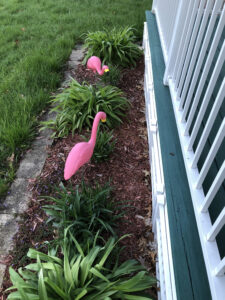
Make friends laugh!
In this “dangerous opportunity” time, doors do actually open for us.
- We can choose to follow current safety guidelines – stay home and wear protective gear when out. We can reach out by phone or other digital means to check on those we love, our neighbors, and our friends.
- We can work on those projects at home that we never get to but now have a little time.
- We can spend that extra time reading to or playing with our children.
Chris Klug, a skilled practitioner gently guided class members through a difficult week. He reminded us that life is like a spiral. We may remember an event or situation. The memory might trigger an emotion. Yet, we have moved from that actual time. It is OK to be with the feeling of grief. Then, as you can, practice the self-care techniques.
Lots have changed and returning to “normal” will not happen. We can right” this topsy-turvy time, adjust, adapt, and form new ways to live and create meaningful lives.
by Winding Pathways | Apr 23, 2020 | Mammals, Nature, Reflections/Profiles, Uncategorized, Wonderment
A few months ago, we posted a blog honoring Smokey Bear on his 75th birthday. Smokey was created by the United States Forest Service in an effort to encourage people to be careful with fire. His was one of the most successful marketing campaigns in history.
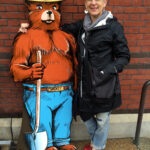
The allure of Smokey Bear.
Smokey is adorable yet commanding. When he said to drown campfires and snuff out cigarettes you did it without question. Today, we know that forest fires are a natural phenomenon with beneficial ecological impacts, but Smokey’s message still resonates.
Two Winding Pathways readers shared their memories of Smokey Bear.
Tracy McPartland of Cedar Rapids sent us a photo of her with Smokey taken at the Smithsonian. “I loved Smokey Bear as a kid. I used to voice imitate him even though I don’t know what his voice was like.”

Smokey has been well-loved.
Jim Rainey is a retired US Army LTC who lives in Pennsylvania. Recently, he told us he received a Smokey doll from Santa in the early 1950s when he was four or five years old. “I was enchanted by Smokey. And, my doll still sits on the chair in my office. Sometimes my dog uses him as a pillow. At age 65, or so, he has patches on his jeans, is missing some hair, and part of his nose is gone. A few years ago, we asked our three daughters what they wanted of our stuff and was surprised when our oldest daughter said she wanted Smokey. Before then I was thinking of having him put in my casket, but I really didn’t want him locked in a box for eternity. I’ll let my daughter enjoy him and think of me,” he said.
Rich also has pleasant memories of Smokey and passed his image whenever he entered the Boise, Clearwater, or Idaho Panhandle National Forests during his college years. In 1974 he was a US Forest Service Hot Shot and fought three wildfires in Idaho. He’s kept a Smokey poster on his office wall for years.
There is confusion. Technically he’s Smokey Bear, not Smokey THE Bear.
A former college contact, the Fazio Family, owns Woodland Catalog Smokey Bear Gifts and has a store in Moscow, Idaho. Anyone wanting Smokey items can order it online. There’s a Smokey Bear museum in a state park in Capitan, New Mexico. You can take a brief virtual tour at
Smokey endures for the ages. His message is clear, and his presence is endearing.
by Winding Pathways | Jan 5, 2020 | Birds, Mammals, Nature, Uncategorized
When the next soft snow falls, go tracking outside! A mid-December 2019 skiff of snow delighted us. There was not enough of the white stuff to shovel but the thin white blanket that covered our yard revealed who visited the night before.
The dimples of deer tracks were clearly visible as we went out to get the newspaper, but one set of tracks was unusual and especially interesting. Four footprints, in a rough line, kept repeating with about three feet of untrod snow between them. Just what animal created them?
-
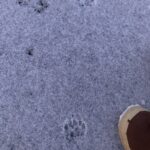
-
A skiff of snow is best for tracking.
-

-
A small bird left tracks in the snow.
-

-
Gottcha!
After a bit of sleuthing, we decided it was a coyote out seeking a mouse or rabbit dinner. Coyotes aren’t rare around our home but they aren’t in the yard often. We wish we could have watched it lope across the yard.
A skiff of snow makes for a delightful walk in the woods, grasslands, or wetlands. Often animals are easy to spot as their dark coats contrast with the white snow and tracking is superb. It’s usually not hard to figure out what animal made the tracks, and following them gives some idea of what the animal was doing and where it was going.
Many Websites and books help with track identification but we like www.naturetracking.com because it shows tracks of animals most likely to be in a backyard.
Happy tracking.
-
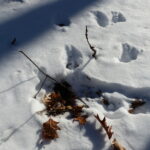
-
Squirrels at work.
-

-
Even humans leave tracks all over.
-

-
Deer paths are most obvious in deeper snow.
by Marion Patterson | May 9, 2019 | (Sub)Urban Homesteading, Bugs, Foraging, Garden/Yard, Nature, Uncategorized
A delightful swatch of color flitted by as we sat on our back deck on one of spring’s first warm sunny days. It was a red admiral butterfly that landed on a post just a few feet from us. It appeared to be enjoying the weather as much as we were.
We’ve since spotted many red admirals in the yard, probably because stinging nettles thrive on the north end of our property. It’s the favored plant for red admiral caterpillars, although they’ll also live on other types of nettles. That poses somewhat of a dilemma.
What is a Red Admiral Butterfly?
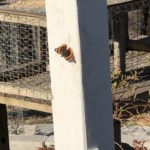
These colorful butterflies depend on early blooming plants like nettles.
Red Admirals are a common butterfly across much of the temperate globe. They’re found across Europe and Asia, North Africa, Hawaii, and much of North America, especially the eastern half of our continent. The larvae feed on stinging nettles, which may not be native. So, if red admirals need stinging nettles what did they eat before the plant was introduced to North America in the early days of European exploration? It’s not even certain that stinging nettles are exotic. They may have been here all along, or early butterflies may have fed on wood nettles.
We appreciate both the insect and plant here at Winding Pathways. Red admirals add color and movement to the yard, while nettles make delicious eating. It’s the first wild green we harvest each early spring.
Can You Eat Nettles?

Carefully pluck the top three leaves off.
Stinging nettles are ready to harvest early – about the time when chard, spinach, and lettuce are planted. When the nettles are just a few inches tall we pluck off the top three or four leaves. They are called stinging nettles because the plant has tiny hairlike stingers. Walk through a patch in summer wearing shorts and nettles cause instant pain. But it’s temporary and not dangerous. Another name for the plant is the “seven-minute itch.” The sting comes from histamines.
We gather young nettles without getting stung by carefully plucking just the top leaves between our thumb and forefinger and snapping them off. About 100 young nettle tops make two servings. We bring them into the kitchen, rinse them a couple of times, and steam them for just a minute or two. The sting disappears and resulting greens are delicious. Plus they pack a nutritious array of vitamins and are high in protein.
Nettle season is short. By the time the plants are eight or ten inches tall, the new leaves are getting tough. But by then we’re harvesting chard and spinach from the garden.
We’re happy to share our yard with both red admirals and nettles. Anyone with a partly shady yard with damp soil might want to start a nettle patch. Wear a pair of gloves and dig up a few and plant them in the yard. They aren’t fussy and will provide excellent table fare and a higher likelihood that the yard will be home to the colorful butterfly.
by Winding Pathways | Jan 10, 2017 | Uncategorized
Sometimes change happens as quickly as flipping a light switch. One moment it’s dark. A second later brightness fills the room. Other changes creep up so subtly that it’s hard to notice them at all.
That’s what happened to my hearing acuity. It probably started years ago when massive machine gun noise assaulted my ears during Army training, and running chain saws, lawn mowers, and other machines didn’t help. Gradually and pretty much unnoticed I developed tinnitus and lost the ability to hear many of nature’s delightful sounds.
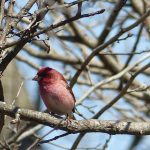
Rich could not hear the sweet sound of the finch.
One day my wife, Marion, and I were sitting in the living room when she asked, “What bird is calling outside the window?” I couldn’t hear a thing! It was time to get my hearing checked and a few days later I was at Heartland Hearing Center in Cedar Rapids. Audiologist Jennifer Reekers positioned me into a small booth and tested my ability to hear sounds of varied intensity and wavelength. The test proved what I already knew. I could not hear many sounds well, especially high pitches.
“Hearing aids will help restore your ability to hear many sounds,” she said. Over the next few weeks, she fitted me with a different trial pairs until I found one that did the trick. It was in spring and I could hear bird calls I hadn’t heard in years. Some sounds were odd, like hearing my own footsteps and my pants legs swooshing together as I walked.
My experience with the aids has been positive and, although they were expensive, it was money well spent. In the Premier section below is an article on the causes of hearing loss and how to improve hearing. It includes tips to protect hearing before loss sets in and what can be done to enable better sound detection and is reprinted from OUTDOORS UNLIMITED Magazine.
Wildlife and Hearing
Humans are fortunate. We have a fair ability to see, hear, taste, and smell. The senses of many wild animals have senses much better than ours, but they usually aren’t as well balanced.
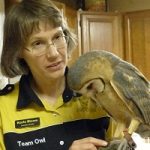
Barn owls can find prey in complete darkness using only their hearing.
For example, according to Karla Bloem, Executive Director of the International Owl Center, a barn owl’s hearing is so keen that it can detect and catch a mouse in complete darkness. Its vision is also outstanding, although probably only in black and white. But, that owl may not have a sense of smell or taste at all.
Like owls, wild turkeys have outstanding vision and hearing but probably no sense of smell or taste.
The sense of smell and hearing possessed by deer is amazingly well developed, but their vision isn’t very good. Humans are fortunate to have all our senses, although none of them may be as keen as those of certain animals. Hearing loss can often be prevented. Take care around loud noise.
“This article first appeared in OUTDOORS UNLIMITED, a publication of the Outdoor Writers Association of America and is re-printed with permission.
“As the gunner fired bursts, my hands guided belted ammo into the big Browning machine gun. The noise was so intense that concussions jarred my skull.
“Military noise, augmented by youthful years in small planes, running power saws, and hunting eventually caught up with me. By my 40th birthday my ears started buzzing. Called tinnitus, noisy ringing has been part of my life for decades.
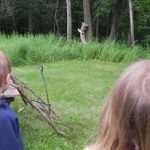
Children’s voices were lost to Rich.
“Gradually it became harder to hear some sounds, especially the high pitch speech of girls. Conversing in a crowd became maddening as I could hear background conversation but not the person in front of me. Eventually wood thrushes and my wife’s expressed concerns convinced me to shun procrastination and seek help. No sound in nature is as magical as the springtime notes of this woodland bird. Several years ago I heard my last thrush. Either they were absent from the woods or my progressive hearing loss blocked their music.
“Studies link hearing loss with depression, dementia, falling, high blood pressure and anxiety but, it was the inability to hear birdsong that launched my search for a solution. I’m not alone. At least one in three people, men and women alike, over age 60 suffer hearing loss. Unfortunately many fail to seek solution.
“Hearing loss is nondiscriminatory. Cumulative noise exposure impacts people of all ages and both genders. A current concern is high volume music from ear buds. As many as a fifth of teenagers may eventually suffer hearing loss from it.
“Advertisers know this, and when my 60th birthday passed I began getting bombarded with hearing aid ads. Some claimed cures for tinnitus and most offered better hearing at bargain prices. Most sounded too good to be true. I decided to seek a certified audiologist and within a week was sitting in a quiet booth as Jennifer Reekers of Heartland Hearing Center tested my ability to hear. It yielded no surprises but was disconcerting. I couldn’t hear high pitches.
“Jennifer holds a doctorate in audiology. She and her business partner, audiologist Diana Kain, patiently answered questions and convinced me that I was not just about to buy hearing aids but was beginning a long term relationship with professionals committed to improving my hearing. They fitted me with a trial pair of hearing aids appropriate for my non-typical lifestyle.
“Usually I work at my computer a few hours, then run a power saw, then back to the computer, then target practice with my .22 rifle. I’m outside in wind, rain, blizzards and other quirks of nature. Sometimes I need to amplify sound then suppress a saw’s roar or a rifle’s bark.
 “Jennifer used marvelous technology to adjust the aids to fit my needs. They aren’t merely amplifiers. They are computers enabling aids to fit varied needs. Jennifer manipulated her computer while tuning my aids to dampen tinnitus and background noise while boosting my ability to hear high pitch sounds.
“Jennifer used marvelous technology to adjust the aids to fit my needs. They aren’t merely amplifiers. They are computers enabling aids to fit varied needs. Jennifer manipulated her computer while tuning my aids to dampen tinnitus and background noise while boosting my ability to hear high pitch sounds.
” The following day I hiked seven miles in Effigy Mounds National Monument amid calling orioles. As I sat on a bluff over the Mississippi the delightful song of a wood thrush filled my ears.
“An important feature of my new aids is a tiny mute button. Just before I pick up my power saw or .22, I mute the aids and slip quality muffs over them. The mute function eliminates the hassle of removing hearing aids before noise exposure.
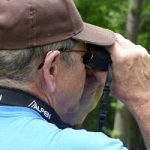
Hearing and locating birds got easier with hearing aids.
“I spent a week trying everything I could think of to frustrate the new hearing aids before I decided to buy them. I went out in the rain and wind and even evicted a black fly that had crawled into my ear. The aids stayed in place and kept working. I couldn’t shake them out. They were comfortable, even after 14 hours and amazed me. One afternoon I rowed to the middle of a smallish lake and could clearly hear bank anglers conversing.
“Expensive! Yes, but being able to hear a thrush and converse with the neighbor kids is priceless. The cost didn’t just buy hearing aids. It established a relationship with the audiologists who are my hearing coaches. I can access them at any time at no additional cost. They’ll tune and clean the aids as the need arises.
“Licensed professional audiologists have a higher degree of training than hearing instrument specialists or hearing aid salespeople and have access to a wide array of hearing aids. Jennifer and Diana have helped me recapture my hearing and their peers can likely help many of the millions of Americans who suffer hearing loss.
PREVENTING HEARING LOSS
“Hearing loss is a stealth condition. Exposure to loud noise is cumulative and gradually permanently degrades hearing. It is the root cause of tinnitus. Correction is outstanding for those of us with hearing problems but prevention is far better. Loud music, lawnmowers, saws, blenders and vacuum cleaners, and especially firearms cause hearing loss that can be prevented.
” Here are recommendations from Audiologists Reekers and Kain:
- Keep the volume down. Teenagers wearing earbuds that channel high intensity music into their ears are preparing for future hearing loss.
- Wear hearing protection whenever exposed to loud noise. Put on the muffs or plugs, even when running the lawn mower or vacuum cleaner.
- Protect children from loud noises.
- When target shooting it’s a good idea to wear both ear plugs and muffs at the same time to further dampen noise. Suppressors help reduce noise but wearing muffs remains prudent.
- Don’t procrastinate. If hearing problems develop find a licensed audiologist!
“Helpful websites are Healthy Hearing and Hearing Health Foundation.
by Winding Pathways | Nov 5, 2014 | Uncategorized
There’s a simple solution to two problems often encountered by people who feed birds in their backyards. Either few birds visit the feeder or the darn birds perch on deck chairs and poop on the furniture.
Birds shun a backyard feeder for many reasons, but the most common is lack of habitat. Birds mainly visit feeders with a wide array of trees, shrubs and grasses with water close by. Offer expensive gourmet bird feed in poor habitat and few birds will come. Those that do will usually be English sparrows and pigeons.
Birds prefer perching on natural branches while waiting their turn to hop on a feeder. If few branches are around they’ll often use outdoor furniture and make a mess.
The long term solution to both problems is to plant a diversity of trees, shrubs, tall grasses and wildflowers in the yard. These can take years to mature. A short term solution is to erect what Winding Pathways calls “Poop Posts.” Scrounge a few dead branches eight or ten feet long, dig a hole and “plant them” in the yard about a dozen feet from feeders and away from furniture. These fake trees give birds a place to perch and when they poop it becomes lawn fertilizer. Come spring simply remove the sticks.
Give yourself and your feathered friends a break and set a poop post in the ground before freeze-up.

















